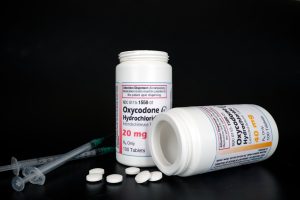Despite more charges, drug deaths rise
By Kevin Beese Staff Writer — October 10, 2023 Fourth in a series looking at drug-induced homicides
Fourth in a series looking at drug-induced homicides
Cook County set an unwanted record last year.
In 2022, the county saw 2,000 individuals die from opioid overdoses, breaking the previous high mark of 1,935 set in 2021, according to the Cook County Medical Examiner’s Office.
More than 91 percent of opioid deaths in the county last year involved fentanyl, a drug up to 50 times more potent than heroin and 100 times more potent than morphine.
“America is facing the worst moment in our history for drug overdoses,” U.S. Sen. Dick Durbin, R-Springfield, said during a visit to the Haymarket Center, a drug-rehabilitation site in Chicago, earlier this year. “More than 3,000 of our friends and neighbors across Illinois died of an opioid overdose in 2021.”
The Fair and Just Prosecution organization found that Illinois and other Midwestern states have been the “most aggressive” in pursuing drug-induced homicide charges in overdoses.
An FJP analysis showed a 300 percent increase (363 to 1,178) in media mentions of drug-induced homicide prosecutions between 2011 and 2016.
Yet the number of overdoses continues to climb.
“The stated intent of many (drug-induced homicide) laws is to prevent overdoses by removing drug sellers from the streets, holding manufacturers and ‘kingpins’ accountable, and deterring future sales,” the organization said in a 2022 report. “In practice, however, they often serve to criminalize the family and friends of the decedent — people who may struggle with substance use themselves — and there is no evidence that drug-induced homicide prosecutions reduce overdose deaths.
“In contrast, there is evidence that such prosecutions often have significant negative unintended consequences, such as eroding the efficacy of critical Good Samaritan laws and deterring people from calling 911 when witnessing an overdose. Approaches to the overdose crisis that are grounded in public health, rather than criminal enforcement have been met with greater success and provide a more humane response to these tragic cases.”
Of the 2,000 people who died in Cook County of opioid overdoses in 2022, 78 percent of them were male.
Blacks made up 56 percent of the deaths; whites constituted 29 percent of the deaths; and Latinos comprised just under 15 percent of the opioid deaths.
The Cook County Medical Examiner’s Office said that 1,825 of the opioid deaths in the county last year were fentanyl related.
In contrast, in 2015, the county had only 676 opioid overdoses, 103 of which were related to fentanyl.
The age group most impacted by opioid overdoses was 50-59, accounting for 27 percent of all Cook County overdoses last year.
According to the Medical Examiner’s Office, the youngest opioid death in Cook County last year was a 12-year-old boy from Chicago; the oldest was an 84-year-old woman from Chicago.
Despite Cook County having the lion’s share of the state’s 3,756 overdoses last year, every county in the Chronicle circulation area (except possibly for Woodford) saw an increase in opioid deaths in 2022, according to the Illinois Criminal Justice Information Authority.
Local counties’ opioid overdoses in 2022 were:
- DeKalb: 21, up four from the previous year
- DuPage: 154, up 33 from 2021
- Kane: 94, up 16
- Kendall: 22, up 11
- Lake: 136, up 26
- Madison: 107, up 30
- McHenry: 53, up 8
- McLean: 24, up 11
- Peoria: 68, up 42
- Clair: 81, up 12
- Tazewell: 33, up 10
- Winnebago: 155, up 33
Woodford County had five opioid overdoses in 2021. Information from the ICJIA only states that Woodford had less than 10 overdoses in 2022.



